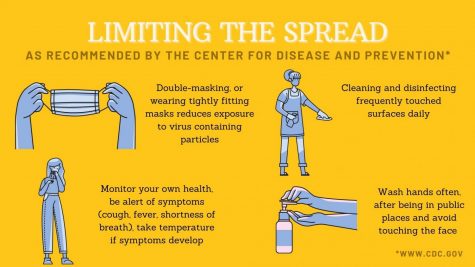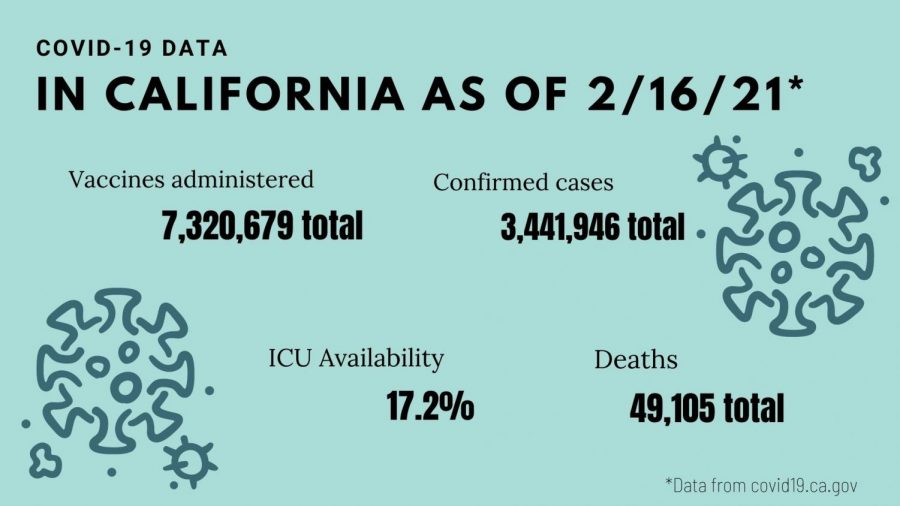Surprise, there’s a new strain in town…
Ventura County’s current COVID-19 risk level is “widespread.” Many non-essential business operations are closed. Infographic by: Yasmin Myers
March 2, 2021
Rest assured it’s not much different than what Ventura County’s currently face.
As COVID-19 cases rage on, citizens of many countries were found with a newer version of the one thing that brought normalcy to a staggering halt. The one year anniversary of the United States’ first COVID-19 cases marks a new mutated version of its predecessor.
These mutations occur for various reasons. According to Hopkins Medicine, the virus’ genes gradually evolve over time. COVID-19 is an RNA virus, meaning that it contains a ribonucleic acid in its genetic material in contrast to the typical DNA strand present. Other RNA viruses include the flu, polio, measles and HIV.
In comparison to common DNA viruses, RNA viruses are especially prone to mutations. Once the host is infected, the virus replicates the infected cells. During this replication, strands of RNA may obtain beneficial traits for its reproduction. Most of these mutations do little to the infectability or fatality of the virus, it very rarely causes the virus to develop a resistance to a specific drug or vaccination.
As it was revealed mid-January, the latest strain of COVID-19 was found in Oxnard sewage wastewater. The Oxnard treatment location includes wastewater from neighboring locations such as Port Hueneme and Camarillo and serves over 240,000 people.
There have been several other variants of COVID-19 found in several countries, including England, Brazil and South Africa. The variant specific to England, named B.1.1.7, can be found in 70% of all COVID-19 cases within England.
Senior Angie Flum stated, “Hearing that there was a new strain of the virus found in Ventura County wasn’t ideal news by any means, and it was a little frightening at first if I’m honest.”
The Ventura County mutation, identified as N501Y, was present in only 0.283% of all recorded COVID-19 viruses found in the wastewater while the remainder were the original Wuhan COVID-19 virus. This variation was first found within the U.S. in Colorado late December. This variant found, however, was not the same as variations found in other countries, as it lacked a key component regarding transmissibility that was present in other strains, meaning there would be little change to the transference of the mutated virus.
Flum continued, “Knowing that it poses very little more threat than the original virus and that the vaccine will likely work against it really soothed any nerves I had regarding the situation. Regardless, I think it’s still so important to socially distance, quarantine and practice wearing masks regularly in order to fight covid and its new counterpart.”

Sophomore Seanna Marie stated, “I think that finding a new strain in VTA is scary because there is a bigger possibility of catching covid now.” Marie continued, “I think we should take more precautions since many people are still going out without masks etc.”
One of the precautions Marie refers to includes double masking, or layering medical masks over cotton masks. The Centers for Disease Control and Prevention outlined maximizing the effectiveness of wearing a well-fitted mask or even layering a medical mask on top of a cloth mask. These experiments revealed that by layering masks, the effectiveness of particle filtration increased accordingly. The details of these studies can be found on the CDC’s website; https://www.cdc.gov/mmwr/volumes/70/wr/mm7007e1.htm
Besides layering or wearing fitted masks, the same prevention strategies stand. It has been recommended to limit gatherings, have good ventilation and socially distance as these are all effective methods of limiting the spread of COVID-19 particles.










